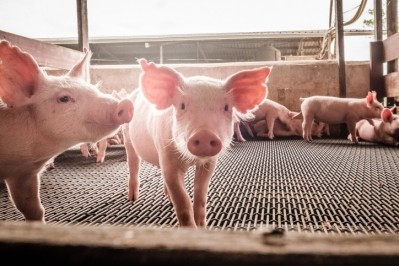special edition: reports from IPPE
Digital tech seeks to boost feed, livestock sector production
This content item was originally published on www.feednavigator.com, a William Reed online publication.
At the International Production and Processing Expo (IPPE) in Atlanta, Georgia, we spoke with SriRaj Kantamneni to hear more about the work that Cargill Animal Nutrition and Health is doing with digital technology and how developments in that area are addressing sustainable production.
“We believe that if we can help the producer become more efficient, more productive that addresses the sustainability challenge that our industry faces,” he told us. “By 2050 we’re going to have to feed nearly 10bn people on this planet and to do that we’re going to need 70% more protein, and really we’re not going to have much more resources than we have today to do all that – that gives you a sense of the very big mission.”
The anticipation is that there could be a rapid change regarding the adoption of technology by the feed and livestock production industries in the next few years, he said. Sector evaluation found that agriculture is one of the least digitized industries in the world.
“What that usually means is that money and investment follow that trend,” he added.
Cargill’s position within the feed and production industries means it can “can help these technology companies address problems in a unique and different way,” he said.
Uniting technology and nutrition could allow producers to address some of the efficiency or sustainability challenges that the industry faces, Kantamneni said. “Because of our nutritional knowledge combined with technology and data when you put those two worlds together, you can really impact productivity.”
“We understand that if you change this nutritional component it’s going to have this kind of effect and we should do that at this stage of the animal’s growth cycle,” he said. “We think that we’re uniquely positioned to do that rather than a tech company that’s just focused on the same outcome but without that knowledge.”
“We’re applying our knowledge of nutrients, our ability to formulate against a nutritional profile, our rich database of supplier selection – knowing grains that originate from one place versus another have different performance parameters – and being able to put all of that together … that completes the loop in terms of being able to impact the outcome,” he added. “That’s what we’re trying to do.”
Developing digital tools
In recent years, the company has moved toward a “much more partner and invest” perspective in terms of developing digital tools for producers, said Kantamneni. However, there does continue to be interest in establishing its own technology.
“We recognize that this is going to take many in our industry to work together – it’s going to take startups, it’s going to take academia, but what we’ve been able to accomplish in the last few years is the beginning of that platform across livestock and aquaculture,” he said. Internally, Cargill has established programs like iQuatic and Enteligen – platforms that use modeling and data science to look at shrimp and livestock production, respectively.
Cargill is also building a farm management system that uses sensors to start digitizing previously manual processes involved with livestock production, he said.
“What we’re doing is taking the partnership with Agriness, which today has a 90% market share of Brazilian pork producers, and we’ve extended that platform into poultry and dairy,” said Kantamneni. “Now we’re stitching our Enteligen capabilities with Agriness’ capabilities.”
Agriness – a swine farm management program that Cargill invested in in 2018 – has a platform that incorporated environmental sensor data with barn and animal performance information, he said. “Where you get varying data sets together into one aggregate view and you start to create more meaningful and actionable insights – and that’s really what we’re chasing after,” he added.
Addressing production challenges
Although early investment in production technology tended to focus in specific areas, as devices and analysis continue to improve those technologies are spreading into new production areas, said Kantamneni.
“So that’s something that we’re excited about because we can start to influence and impact that,” he said. “We have a sense of what some of the big challenges by protein species are, and to be able to start to impact applying one capability and one set of problems to another species is pretty exciting.”
Cargill’s work with Agriness is one example, he said. “They started in pork and they started in Latin America – we’re taking that global and we’re taking that core offering in pork and we’re expanding that into poultry and dairy, so you start to have the network effect or platform effect happening.”
One example of how the expansion works is to look at what are common problems for different production sectors, said Kantamneni. Technology developed to improve production during the grow-out stage is swine could be adapted to provide more insights for broiler production.
“We’re doing some unique things with bodyweight production across both of those species,” he said. “That’s an example of taking a problem in one species applying it to another species – similar concepts, similar technologies are applied and our investment in one technology enables us to do something in another species and we’re already starting to see value in that.”
With broiler production, improved understanding and predictive abilities could lead to an additional production cycle in a given house, he said. “Because you’re getting more efficient with your grow-out phase, now you’re taking the same assets, same barns and you’re introducing an entirely new cycle –that’s a 25% productivity gain on the same asset footprint.”














